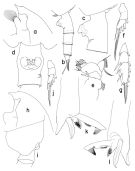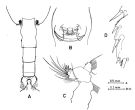|
|
 |
Fiche d'espèce de Copépode |
|
|
Calanoida ( Ordre ) |
|
|
|
Clausocalanoidea ( Superfamille ) |
|
|
|
Euchaetidae ( Famille ) |
|
|
|
Paraeuchaeta ( Genre ) |
|
|
| |
Paraeuchaeta vorax (Grice & Hulsemann, 1968) (F,M) | |
| | | | | | | Syn.: | Euchaeta vorax : Grice & Hulsemann, 1968 (tab.2, p.331, Descr.F, figs.F); Park, 1975 c (p.21, Descr.M, figs.F,M, Rem.);
Pareuchaeta striata Tanaka & Omori, 1968 (p.257, figs.F) | | | | Ref.: | | | Bradford & al., 1983 (p.23); Park, 1994 (p.322, 327, zoogéo); 1995 (p.61, Rem.F,M, figs.F,M) |  issued from : T. Park in Bull. Scripps Inst. Oceanogr. Univ. California, San Diego, 1995, 29. [p.166, Fig.56]. Female: forehead (left side); b, urosome (left); c, d, genital somite (left, ventral, respectively); e, Mx1 (first inner lobe omitted), posterior; f, exopod of P1 (anterior); g, exopod of P2 (anterior). Nota: Similar in habitus to P. gracilicauda but distinguishable from it. Laterally, rostrum thick and relatively short, pointing obliquely forward almost in parallel to anteroodorsal margin of forehead, its anterior margin beginning a short distance from suprafrontal sensilla and straight. Laterally, genital somite including prominence with a depth-length ratio of about 100:137. Dorsal wall smoothly curved with peak about 1/3 its length from proximal end. Genital flange with nearly straight ventral marin and produced distally into a large lobe pointing posteroventrad. Posterior edge of genital field also produced into a large lobe.Posterior margin of genital prominence distinctly set apart from posterior edge of genital field and continuing on to vental wall of somite in a smooth curve.A conspicuous ride is present close to posterior ventral wall on left side of genital somite. Cephalosomal appendages and swimming legs similar to those of P. gracilicauda with expeptions: Outer lobe of Mx1 with 1 or 2 minute setae in addition to 5 long setae: outer spine of 2nd exopodal segment of P1 far short of reaching base of following outer spine. In P2 exopod, outer spine of 2nd segment slightly longer than 2nd outer spine of 3rd segment, 1st outer spine of 3rd segment nearly twice as long as 3rd. Male: h, forehead (left); i, last pedigerous and genital somites (left); j, exopod of P1 (anterior); k, l, distal exopodal segments of left 5th leg (lateral, medial, respectively).
|
 issued from : O. Tanaka & M. Omori in Publs Seto Mar. Biol. Lab., 1968, XVI (4). [p.257, Fig.21]. As Pareuchaeta striata. Female: A, last thoracic segment and urosome (dorsal); B, genital complex (ventral); C, Mx1; D, distal part of exopod of P2. Nota: The urosome segments and furca are in the proportional lengths as 44:22:20:3:11 = 100. Prosome and urosome are in the proportional lengths as 68 to 32.
|
 issued from : G.D. Grice & K. Hulsemann in Pacif. Sci., 1968, 22 (3). [p.330, Figs.49-52]. As Euchaeta vorax. Female (from SE Pacific): 49, forehead (lateral); 50, 4th and 5th thoracic segments and urosome (lateral); 51, genital segment (dorsal); 52, exopod of P2.
|
 issued from : T. Park in Smiths. Contr. Zool., 1975, 196. [p.22, Fig.19]. As Euchaeta vorax. Female (G. of Mexico): a, forehead (lateral); b, genital segment (dorsal); c, same (left side); d, same (ventral); e, P1 (anterior); f, P2 (anterior). pr = posterior ridge of genital field. Nota: This species was originally described by Grice & Hulsemann (1968) from a single female captyred in the eastern South Pacific, and characterized mainly by the presence of a knob on the dorsal side and another on the left side of the genital segment. A reexamination of the holotype, without a distinct knob on the dorsal side of the genital segment, was practically identical with the specimens obtained from the Gulf of Mexico and Caribbean Sea. Male: g, forehead (lateral); h, P1 (anterior); i, P2 (anterior); j, P5 (anterior); k, exopod of left P5 (anterior); l, same (medial). Nota: The male is described here for the first time. The species is found in samples taken from depths exceeding 1000 m in the Gulf of Mexico and western Caribbean Sea, the first record since its discovery in the eastern South Pacific and western North Pacific.
|
 Paraeuchaeta vorax Paraeuchaeta vorax Female: 1 - See key to species Groups and independent species of Paraeuchaeta (p.30): malayensis species Group. 2 - Outer spine of 2nd exopodal segment (or the 2nd of the first 2 exopodal segments forming a proximal, compound segment) of P1 normally developed (Fig.56-f). 3 - Outer lobe of Mx1 with 5 long setae in addition to a minute seta proxymally (Fig.56-e). 4 - Laterally, genital prominence low with more or less convex genital flanges (Fig.56-c). 5 - Laterally, rostrum well developed (Fig.56-a). 6 - Laterally, posterior margin of genital prominence smoothly merging into posterior ventral wall of somite (Fig.56-c). 7 - Genital somite with conspicuously ridged outgrowth on left side posterior to genital prominence (Fig.56-c).
| | | | | Ref. compl.: | | | Suarez-Morales & Gasca, 1998 a (p.109); Hsiao & al., 2004 (p.325, tab.1) | | | | NZ: | 6 | | |
|
Carte de distribution de Paraeuchaeta vorax par zones géographiques
|
| | | | | | | | |  Carte de 1996 Carte de 1996 | |
 issued from : T. Park in Hydrobiologia 292/293, 1994. [Fig. 3, p.327].
Geographical distribution of Paraeuchaeta vorax (triangle). issued from : T. Park in Hydrobiologia 292/293, 1994. [Fig. 3, p.327].
Geographical distribution of Paraeuchaeta vorax (triangle). |
| | | | Loc: | | | Indian, China Seas (South China Sea), E Taiwan , NW Pacif. (tropical), Japan (Izu), S Pacif. (central tropical), off Juan Fernandez Is., Gulf of Mexico, Caribbean Sea | | | | N: | 4 | | | | Lg.: | | | (3) F: 7,3-6,9; M: 6,66; (19) F: 6,75-6,41; M: 6,66; (63) F: 7,78-7,21; (100) F: 7,25; {F: 6,41-7,78; M: 6,66}
The mean female size is 7.086 mm (n = 7; SD = 0.4424), and the mean male size is 6.660 mm (n = 2). The size ratio (male : female) is probably between 0.98 and 0.94. | | | | Rem.: | bathypélagique.
Les vérifications des échantillons correspondant aux différentes régions citées, effectuées par Park (1975 c, 1995), confirment l'originalité de la répartition géographique de cette espèce. Ce fait montre les limites de ce critère ainsi que celui des tailles (7,21-7,78 mm pour les formes femelles du Pacifique contre 6,41-6,75 mm pour celles des Caraïbes) dans le doute que l'on peut avoir sur la validité de la répartition des espèces.
La distribution géographique de cette espèce semble en relation avec le fermeture de l'Isthme de Panama.
Voir aussi les remarques en anglais | | | Dernière mise à jour : 11/08/2016 | |
|
|
 Toute utilisation de ce site pour une publication sera mentionnée avec la référence suivante : Toute utilisation de ce site pour une publication sera mentionnée avec la référence suivante :
Razouls C., Desreumaux N., Kouwenberg J. et de Bovée F., 2005-2025. - Biodiversité des Copépodes planctoniques marins (morphologie, répartition géographique et données biologiques). Sorbonne Université, CNRS. Disponible sur http://copepodes.obs-banyuls.fr [Accédé le 05 janvier 2026] © copyright 2005-2025 Sorbonne Université, CNRS
|
|
 |
 |








